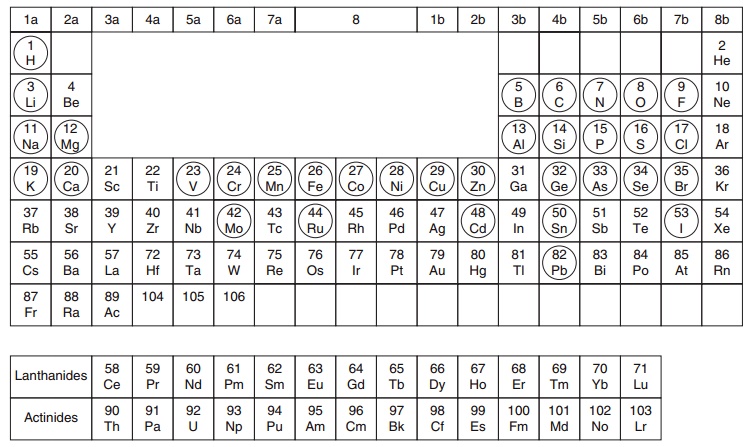Chapter: Introduction to Human Nutrition: Minerals and Trace Elements
Minerals and Trace Elements
Minerals and Trace Elements
Introduction
Essential minerals, including the trace elements, are inorganic
elements (see Figure 9.1) that have a physi-ological function within the body.
These must be supplied in the diet (food and fluids) and vary from grams per
day for the major (macro) minerals through milligrams to micrograms per day for
the trace elements.

Figure 9.1 The periodic table of the elements. The widely accepted or putative essential elements are encircled.
It has been proposed that the environment (most probably in the
primordial sea around hydrothermal vents) in which living organisms evolved was
a primary determinant of which elements became essential for life by providing
structural integrity and catalytic ability to the first complex organic
mole-cules. As life evolved from the oceans on to land, a natural selection
process may have resulted in some elements becoming relatively more important
because of superior catalytic abilities over other elements. In any event, the
uneven distribution of elements in a land-based environment meant that
efficient homeo-static mechanisms had to be in place to conserve essential
elements and to eliminate excesses of essen-tial and nonessential elements. The
processes of absorption from the gastrointestinal tract and excre-tion with
body fluids, therefore, are major ways in which the concentration and amount of
an element can be controlled in the body. In addition, storage in inactive
sites or in an unreactive form can prevent an element from causing adverse
effects in the body, and release from storage can be important in times of
dietary insufficiency.
All elements have the potential to cause toxic symp-toms,
whereas some, the known essential elements in Figure 9.1, have the potential to
cause deficiency symptoms. Even so, deficiencies of only four of these
inorganic elements are known to be prevalent in human populations. Two of these
deficiencies, iodine and iron, are widespread in human populations whereas the
other two, zinc and selenium, only occur in some population groups under
specially defined conditions. Overt clinical signs of deficiency of any of the
other inorganic elements are exceptional in humans and mainly occur secondary
to other clinical conditions. Such observations do not preclude the possibility
that suboptimum status of the great major-ity of the elements indicated in
Figure 9.1 is impor-tant in human nutrition. Indeed, there is an increasing
awareness of the potential role of suboptimal as well as supraoptimal
nutritional status of minerals and trace elements in the development of
degenerative age-related diseases, such as coronary heart disease, cancer, and
osteoporosis. Moreover, other elements, which currently have no published
dietary recom- mendations but are highlighted in Figure 9.1, might prove to be
essential for the optimum health and well-being of humans.
Major constraints to the elucidation of the poten-tial roles of
minerals and trace elements in the onset of degenerative diseases include
difficulties in assess-ing status, and thereby defining requirements, and
myriad interactions among minerals and other nutri-ent and nonnutrients in the
diet. Sometimes, natural experiments of genetic disorders can throw light on
the potential roles of minerals in disease processes and these will also be
discussed as appropriate in the following sections.
Related Topics